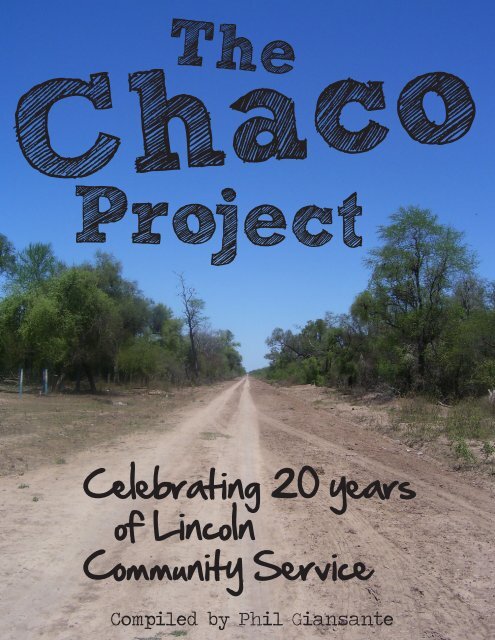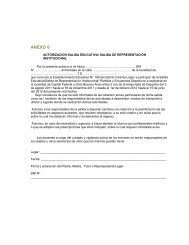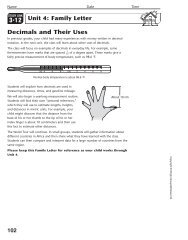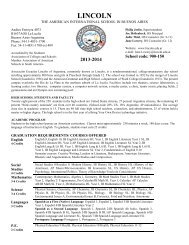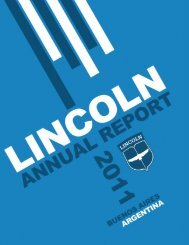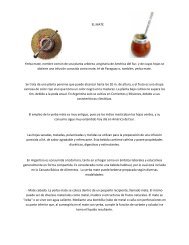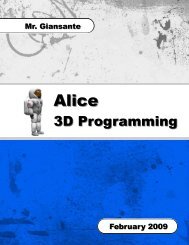The Chaco Project Book - Asociación Escuelas Lincoln
The Chaco Project Book - Asociación Escuelas Lincoln
The Chaco Project Book - Asociación Escuelas Lincoln
Create successful ePaper yourself
Turn your PDF publications into a flip-book with our unique Google optimized e-Paper software.
<strong>The</strong><br />
<strong>Chaco</strong><br />
<strong>Project</strong><br />
Celebrating 20 years<br />
of <strong>Lincoln</strong><br />
Community Service<br />
Compiled by Phil Giansante
A book presented to <strong>Lincoln</strong> students by kindergarten students, 2008<br />
He told us that we are the people<br />
that have been blessed with the<br />
opportunity to help the world, to<br />
help the people of <strong>Chaco</strong>. He was<br />
letting us realize that we are the<br />
ones who can change the world.<br />
- Greg Hawley, 2009<br />
recounting a conversation with<br />
a village leader
If given an option between doing something<br />
and not doing it, you have to do it;<br />
because you’ve already done the “not do it” part.<br />
- Sam Sheridan, “A Fighter’s Heart”<br />
“Be the change you want to see in the world.”<br />
- Mahatma Gandhi<br />
Never doubt that a small group of thoughtful,<br />
committed citizens can change the world; indeed,<br />
it’s the only thing that ever has.<br />
- Margaret Mead<br />
Service to others is the payment you make for<br />
your space here on earth.<br />
- Muhammad Ali<br />
Never before has man had such a great capacity to<br />
control his own environment, to end hunger, poverty<br />
and disease, to banish illiteracy and human misery.<br />
We have the power to make the best generation of<br />
mankind in the history of the world.<br />
- President John F. Kennedy
Twenty Years of<br />
Community Service<br />
by Silvina López Fernandez<br />
<strong>The</strong> first community service trip to <strong>Chaco</strong> occurred in 1991 but the liaison with the<br />
<strong>Chaco</strong> community was established in 1989 by former CAS Coordinator Matilde Flesc.<br />
For the first two years, the school simply sent donations of food, clothing, shoes, toys,<br />
school supplies, etc.<br />
Subsequently, a yearly one-week trip to <strong>Chaco</strong> was established. During this trip,<br />
students visit the schools we built to paint, complete the buildings, repair what<br />
was broken, distribute donations and play with the children. We also take part in<br />
cultural exchanges with the Toba aboriginal community.<br />
Over a twenty year period, <strong>Lincoln</strong> students have built five schools so that children<br />
living in the most isolated Toba and Criollo villages of “el Impenetrable” could<br />
attend school.<br />
Thanks to our work in <strong>Chaco</strong>, 194 families are now sending 682 kids to school.<br />
<strong>Lincoln</strong> community service also supports the local hospital, particularly the<br />
"Niñas Madre Toba" program which assists teenage mothers.<br />
Recently, we began supporting the “Gotitas de Amor” orphanage, whose task is to<br />
shelter, raise and educate orphans and abandoned children.
<strong>The</strong> Early Years<br />
by Matilde Flesc<br />
When I started the Community Service <strong>Project</strong> at <strong>Lincoln</strong> in 1988, I never thought that<br />
it would develop into such a complex program that continues until present — thanks<br />
to the work of Silvina López Fernandez.<br />
We began, in 1989, by sending boxes of donations to rural schools through<br />
sponsorships offered by the <strong>Asociación</strong> de <strong>Escuelas</strong> Rurales (APAER). After two years<br />
of written communication, I decided to ask permission to take a group of students<br />
to Castelli, <strong>Chaco</strong>. It took a lot of time to plan and raise the money for the 40<br />
students and 4 teachers who would go on the trip. We hired the biggest bus we could<br />
find and gathered donations during two months.<br />
To visit the Toba neighborhoods for the first time was a very shocking experience<br />
for all of us — one knows about poverty because you see it on TV or read about it,<br />
but when you see if first hand, it is something that will stay with you forever.<br />
<strong>The</strong> fourth year of our trip, we started to build one room schools in some very<br />
forsaken villages of the Impenetrable where we couldn’t imagine how people survive<br />
with so little in the middle of nowhere, with almost no communication with the<br />
outside world.<br />
This project was something very special that started from the need to teach our<br />
students to share with those who have less and to show a little of Argentine’s true<br />
struggle to survive to the students that would, one day, be in positions of power to<br />
change the lives of those who need their help.<br />
I was overjoyed to know that when I left <strong>Lincoln</strong>, Silvina would continue with the<br />
program and that the commitment was not only a personal one but an institutional<br />
one as well. One community helping another community. We began twenty years ago<br />
with this commitment and that is what this is – a commitment of affection and trust<br />
that exists between <strong>Lincoln</strong> and the people of <strong>Chaco</strong>.
About <strong>Chaco</strong><br />
Population of <strong>Chaco</strong>:<br />
1,052,185<br />
Population of Castelli:<br />
28,000<br />
<strong>The</strong> population of <strong>Chaco</strong> consists of ...<br />
20 percent “Gringo”<br />
(descendents of Europeans who reached<br />
Argentina after World War II).<br />
40 percent “Criollos” (gaucho).<br />
40 percent Toba/Wichi<br />
(living in adobe/straw rancho houses)<br />
Life expectancy is 69 years, six years less<br />
than the average of the country.<br />
In 2007, fifteen Toba chaqueños died from lack of food.<br />
Over 50 percent of the Toba/Wichi community’s young population have not<br />
finished elementary education.<br />
In 2008, the NGO “Study Centre Nelson Mandela” warned of worsening hunger<br />
conditions and poverty among Aboriginal communities in <strong>Chaco</strong>.<br />
In September 2009, while we were in Castelli , the “Marcha contra el hambre”<br />
brought together 3000 chaqueños, who traveled 200 km from Pampa India<br />
to the provincial capital.<br />
Sources:<br />
centromandela.com.ar<br />
jjcastelli.gov.ar<br />
unicefninezindigena.org.ar
<strong>The</strong> Toba People of <strong>Chaco</strong><br />
<strong>The</strong> Toba are an ethnic group in Argentina, Bolivia<br />
and Paraguay. As of 2005, there are 47,951 Toba in<br />
Argentina, living mainly in the provinces of <strong>Chaco</strong>,<br />
Formosa and Santa Fe.<br />
<strong>The</strong> <strong>Chaco</strong> region in the north of Argentina and<br />
part of Paraguay was formerly covered with forests.<br />
<strong>The</strong> Toba were originally nomadic hunter–gatherers<br />
who, upon the arrival of the Spanish, adopted the<br />
horse and resisted colonial encroachment and<br />
missionization for several centuries.<br />
In the 1880s the Argentine government began a<br />
campaign to occupy new territories, defeating the<br />
last organized attempts by the Toba to defend<br />
their lands. <strong>The</strong> Argentine <strong>Chaco</strong> was divided up<br />
in large portions and exploited, especially for<br />
the valuable quebracho tree, used for its tannin<br />
and its extremely durable timber. This devastated<br />
the ecosystem in a relatively short time. <strong>The</strong><br />
private owners of the <strong>Chaco</strong> then turned to cotton<br />
production, employing the Toba as a cheap<br />
seasonal workforce; the conditions did not<br />
change substantially for decades.<br />
Beginning in 1982, the region suffered unprecedented floods, which caused crops to<br />
be ruined; and in the 1990s, mechanical harvesters imported from Brazil left many<br />
Toba without jobs. <strong>The</strong> provincial government of <strong>Chaco</strong> resorted to pay a one–way<br />
ticket to the Toba willing to migrate south into Santa Fe.<br />
Source: Toba (Tribe), Wikipedia.org
Tobas Suffer Neglect<br />
by Daniel Schweimler, BBC News - Argentina, September 27, 2007<br />
<strong>The</strong> Toba are one of the few remaining<br />
indigenous groups in Argentina. <strong>The</strong>y live<br />
in “<strong>The</strong> Impenetrable Forest”, the poorest area<br />
in the poorest province of the country. <strong>The</strong><br />
early Spanish settlers wrote about the Tobas<br />
saying they were a fierce people, hardened by an<br />
inhospitable terrain.<br />
<strong>The</strong> Toba are a tiny minority in Argentina, with<br />
only 18,000 people. Argentina has one of the<br />
smallest indigenous communities in the Americas,<br />
making it difficult for them to find a voice and<br />
maintain their language and customs.<br />
Poverty and Malnutrition<br />
Many look much older than they are, and are suffering from tuberculosis or the<br />
effects of Chagas disease, caused by a parasitic insect. <strong>The</strong>se are illnesses with<br />
their roots in poverty.<br />
Many Toba still live in primitive mud and stick huts. <strong>The</strong> straw roof provides<br />
little protection from the relentless heat that batters <strong>Chaco</strong> province in the<br />
summer. <strong>The</strong> Toba hunt and gather wild fruits. But the growth of soya production in<br />
recent years has enticed farmers to the region in search of new lands to cultivate.<br />
Deforestation<br />
<strong>The</strong> local branch of the environmental<br />
organization, Greenpeace, has warned<br />
that massive deforestation is<br />
threatening some native groups with<br />
extinction. To make matters worse,<br />
the traditional cultivation of cotton<br />
in <strong>Chaco</strong>, which used to provide the<br />
Toba with seasonal work, is being<br />
replaced by less labour–intensive soya<br />
production.<br />
<strong>The</strong> impenetrable forest is becoming<br />
less impenetrable and with it the<br />
Toba are losing their lands and<br />
livelihoods. Many have emigrated to<br />
the cities where large communities<br />
struggle to earn a living in<br />
burgeoning shanty towns.
Agony of the Toba People<br />
Translated from sections of the article “El Impenetrable o la agonía Qom“<br />
by Mempo Giardinelli, Página/12, September 25, 2007<br />
<strong>The</strong>se days the <strong>Chaco</strong> attracts the attention of<br />
everyone. Global print and television come to watch<br />
the ravages of malnutrition affecting thousands of<br />
aborigines in the woods known, improperly nowadays,<br />
as “El Impenetrable”.<br />
First we stopped in Saenz Peña, <strong>Chaco</strong>’s second<br />
largest city (pop. 90,000), for a clandestine visit,<br />
not requested, nor approved, to the Hospital Ramon<br />
Carrillo, the second largest in the province.<br />
Although the front of the hospital is freshly<br />
painted, there is a garbage dump behind. Glass and<br />
broken furniture, radiology and surgical “debris”<br />
give frame to the rooms where patients are only<br />
bodies ravaged by diseases such as tuberculosis and<br />
Chagas disease. I’m shocked by the many people who<br />
are lying on the floor, not knowing if they<br />
are patients or relatives<br />
An hour later, on the way to the city of Juan José<br />
Castelli (pop. 30,000) that calls itself “Portal del<br />
Impenetrable” - the distress and anger are perfected<br />
as I observe what remains of the <strong>Chaco</strong> forest.<br />
A forest that was once ruled by hundred year old<br />
quebrachos trees and wonderful fauna are now<br />
burned fields of sandy soil and desert, with stumps<br />
everywhere waiting for the bulldozers to prepare<br />
the ground for soybean.<br />
Again in Castelli, we enter the hospital through<br />
the back door; we were not invited. This hospital<br />
supposedly serves 90 to 95 percent of the Aboriginal<br />
people throughout the Impenetrable. What I see<br />
there hits my chest: at least two dozen people in<br />
inhumane conditions looking more like “ex-people”;<br />
just skin over bones, looking like pictures of bodies<br />
in Nazi concentration camps.<br />
A 37 year old woman who weighs less than 30 kilos<br />
looks over 70. She can not raise her arms and does<br />
not understand what is asked to her. Five yards<br />
away an elderly woman (or so it seems) is just a pile<br />
of bones on a rickety bed. <strong>The</strong> musty smell is
unbearable, the buzzing flies seem to be the only<br />
ones that are healthy in this hospital. <strong>The</strong>re<br />
are no doctors in sight and there reigns a heavy<br />
silence, heavy and accusing. Family members wait<br />
beside the beds, or lie on the floor in the hall on<br />
filthy blankets, as if they are waiting for a death<br />
that is taking too long to come.<br />
I feel a new and growing anger, an absolute<br />
powerlessness. I ask a young nurse who is<br />
cleaning a glass if the same situation is common.<br />
“Always,” she replies, “although lately they have<br />
taken away many, since the reporters started<br />
coming.”<br />
I walk down another hallway and get to obstetrics<br />
and pediatrics. Here, everyone is Toba. A girl cries<br />
with her son, a brown bag of bones with two huge<br />
eyes. Another young woman says she does not know<br />
what is wrong with her baby but she does not want<br />
him to die; but clearly the baby is dying. <strong>The</strong>re are twenty beds in the sector and<br />
each one bears witness to extreme malnutrition; the sheets are filthy, flies buzz<br />
constantly, desolation and fear are in the eyes of everyone.<br />
“El impenetrable”, over three million hectares, was sold with the Aboriginal people<br />
inside. <strong>The</strong>re are several thousands and they have always been there, but without<br />
titles to their property. <strong>The</strong> result is the devastation of the Impenetrable; when<br />
the forest is cleared, the animal species disappear, become extinct. Human beings<br />
also. And while some good urban souls<br />
say otherwise, and certain leaders are<br />
offended by the thought, harsh words<br />
such as extermination and genocide are<br />
valid.<br />
Unintentionally ironic, I evoke the poet<br />
Atahualpa Yupanqui: “Here, God did not<br />
pass.” That evening I am heartbroken<br />
and only manage to scribble these notes,<br />
indignant, conscious of its uselessness.<br />
About 400 miles from here the final<br />
election count progresses slowly.<br />
Officials of the provincial Health<br />
Minister continue to deny all this, while<br />
the governor prepares to move to Buenos<br />
Aires to be a senator, far from <strong>Chaco</strong>, as<br />
almost all legislators.<br />
Never before has this country and <strong>Chaco</strong><br />
hurt me so much.
Severe Drought<br />
<strong>Chaco</strong> has been affected by severe<br />
drought conditions over the past<br />
years. This has led to failed crops<br />
and has devastated the agricultural<br />
economy.<br />
Toba communities lack safe<br />
drinking water and are forced to<br />
drink from puddles or dams that<br />
they share with animals, adding<br />
to malnutrition and resulting in<br />
high health risk.
Student Experiences<br />
<strong>Chaco</strong> is a good experience and a<br />
crucial one, when attempting to<br />
comprehend our society. We were able<br />
to see, to some extent, the poverty<br />
surrounding us everyday and how<br />
important it is to work together in<br />
order to solve this problem.<br />
- Juan Estrada, 1999<br />
I knew <strong>Chaco</strong> would be a big event,<br />
I just wasn’t expecting this event<br />
to change my life. I hold <strong>Chaco</strong> in<br />
my heart, my head, in me, and I am a<br />
changed person because of it.<br />
- Johnny Bree, 1999<br />
I think the best part of the trip<br />
was getting the hands-on experience<br />
helping the people and learning<br />
from them while at the same time<br />
they were learning from us.<br />
- Shaleen Alisa Somji, 1999
When we returned to the kindergarten this year,<br />
I saw a little girl I met last year and she was<br />
wearing the same shirt as the last time I saw her.<br />
I know that this was probably the only shirt she<br />
owns. It was dirty and not her size.<br />
- Lea Golisch, 2009<br />
We give them hope; hope that they live off and<br />
depend on. If we stop now, what will happen<br />
to the communities, the people and their<br />
education, their lives?<br />
- Lea Golisch, 2009
Early in the morning we went to the<br />
Cemetery to plant a tree for Leo Yulan´s<br />
three year old daughter who had died in a<br />
car accident four days before we arrived.<br />
Leo is the mayor of the city and has<br />
been our guide and liaison for the last<br />
nine years in Castelli. It was very sad<br />
especially for those of us who went last<br />
year and knew Leo and his little girl.<br />
- Suzanne Barrozzi, 1999<br />
I’d never been on a community service<br />
trip where everything was so handson<br />
before. Dealing directly with the<br />
people you are helping changes things<br />
considerably.<br />
- Gabi Ziomek, 2009<br />
It was an experience that changed me,<br />
and helped me discover certain things<br />
about myself. I am very grateful for<br />
having had the chance to take part<br />
in this amazing trip.<br />
- Gabi Ziomek, 2009<br />
<strong>Lincoln</strong> provided me with an<br />
education, but <strong>Chaco</strong> awoke in me<br />
an awareness of the real world.<br />
- Natasha Knechtel, 1993
All these kids want is to be loved and<br />
cared about. <strong>Chaco</strong> is not just a trip;<br />
it’s a life changing experience. I feel<br />
honored to be a part of a twenty year<br />
legacy that hundreds of kids have<br />
formed. <strong>The</strong> bonds we build with the<br />
people there are much more than a<br />
simple donation.<br />
- Mary McClain, 2009<br />
I think what separated it from any<br />
other community service oriented<br />
trips was the fact that we were able<br />
to establish relationships with the<br />
people, and actually be around them<br />
most, if not all, of the time. <strong>The</strong>re<br />
are countless occasions in which<br />
I can say I was deeply moved or<br />
developed an important connection<br />
with a person there.<br />
- Sergio Hurtado, 2009<br />
<strong>Chaco</strong> is a place where a smile<br />
leads to a new friend, where an<br />
object as common as a crayon<br />
gifts new paths of creativity<br />
that lead oblivious children<br />
to uncover their own abilities,<br />
and where our presence is in<br />
higher demand than ever before.<br />
- Mariah Cushman, 2009<br />
One of the things that impressed<br />
me was the way people welcomed us.<br />
When the bus got to on the schools,<br />
people would clap and cheer.<br />
- Linda Chung, 1999
A family comes in. Three young boys take their<br />
seats in our little corner, anticipation in their<br />
eyes. Most likely this will be the first time they<br />
get new shoes since the last time we came. And the<br />
last time they will get any more until we come<br />
back next year. <strong>The</strong> two older brothers each get a<br />
pair of shiny new soccer cleats. <strong>The</strong> happiness in<br />
their eyes is contagious, we smile. <strong>The</strong> smallest<br />
brother gets no shoes, there are no more shoes of<br />
his size. We ask the people passing us shoes to<br />
look better. We ask again. And again. He cries.<br />
- From “96 pairs of shoes” by Julian Modiano, 2009<br />
Silvina once said to us that a<br />
little boy she sees every year, when<br />
we visit the community, said to her:<br />
“<strong>The</strong> only happy day of the year for<br />
me is when you come.”<br />
- Lea Golisch, 2009<br />
It is an experience which few<br />
people are given the opportunity<br />
to feel. But those select few<br />
which are allowed to go, will<br />
forever remember it.<br />
- Carlos Sevilla, 1999
What began as a long, sweaty and tiring<br />
journey to the small province of <strong>Chaco</strong>,<br />
Argentina, ended as one of my favorite<br />
community trips. We were all oblivious<br />
to the heart-warming experience that was<br />
to take place. Although some had already<br />
visited the province before, the rest were<br />
new to the ‘<strong>Chaco</strong>’ experience filled with<br />
kids, painting, building and bonding. I<br />
had never seen poverty to such a scale,<br />
in front of my eyes.<br />
- Garima Batra, 2009<br />
One of the highlights of the trip for<br />
me was the religious ceremony, where we<br />
observed how the local Aborigines let go<br />
of their sins by running in circles,<br />
and praying.<br />
- Garima Batra, 2009<br />
<strong>Chaco</strong> is so much more than a community service trip,<br />
it’s a lifelong memory that a person will hold onto<br />
forever. It creates a relationship and a connection<br />
with the people of the Toba community, one that should<br />
be shared with the people around you.<br />
- Kaitlyn Duplak, 2009
Donations
Building
Maintaining
Group Pictures<br />
Building at Telasco<br />
2004<br />
Opening Ceremony<br />
at Puerta Negra<br />
2004<br />
Pampa Argentina<br />
2007
Posing at the newly<br />
finished kitchen at<br />
El Estanque school<br />
2007<br />
2008<br />
2009
Dedicated to Silvina López Fernandez<br />
and Matilde Flesc.<br />
Special thanks to the hundreds of <strong>Lincoln</strong> students who<br />
have given of their time and energy to making the<br />
<strong>Chaco</strong> community service project a reality<br />
over the past twenty years.


